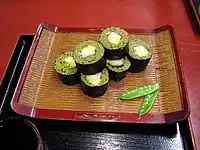 Dried soba | |
| Type | Noodles |
|---|---|
| Place of origin | Japan |
| Serving temperature | Hot, cold |
| Main ingredients | Buckwheat |

Soba (そば or 蕎麦, "buckwheat") are thin Japanese noodles made from buckwheat. The noodles are served either chilled with a dipping sauce, or hot in a noodle soup. The variety Nagano soba includes wheat flour.
In Japan, soba noodles can be found in a variety of settings,[1] from "fast food" venues to expensive specialty restaurants. Markets sell dried noodles[2] and men-tsuyu, or instant noodle broth, to make home preparation easy. A wide variety of dishes, both hot for winter and cold for summer, uses these noodles.
The amino acid balance of the protein in buckwheat, and therefore in soba, is well matched to the needs of humans and can complement the amino acid deficiencies of other staples such as rice and wheat (see protein combining). The tradition of eating soba arose in the Edo period.
History of soba in Japan, development of eateries
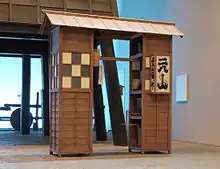

The tradition of eating soba originates from the Tokugawa period, also called the Edo period, from 1603 to 1868. In this period, every neighborhood had one or two soba establishments, many also serving sake, which functioned much like modern cafes where locals would stop for a casual meal.[3] At that time, the population of Edo (Tokyo), being considerably wealthier than the rural poor, were more susceptible to beriberi due to their high consumption of white rice, which is low in thiamine.[4] It was discovered that beriberi could be prevented by regularly eating thiamine-rich soba.[5]
The delivery of food called demae was originally a service for wealthy daimyō in the 1700s.[6] Until the late Showa period, piles of soba bowls were packed on the shoulders of bicycle couriers.[6] In March 1961, new cycling traffic laws added restrictions.[6] Officials of the Tokyo Metropolitan Police Department said, “To ride on a bicycle with piles of ‘soba’ bowls on your shoulder is dangerous.[6] It must be prohibited from the viewpoint of road traffic safety.[6] But we will not place any stricter curb as they will lose more than half their customers,” and, “With this police assurance to overlook the illegal traffic practice, ‘soba’ delivery boys will continue to race through the streets of Tokyo.”[6] This method of soba delivery is not practiced anymore.
Some establishments, especially cheaper and more casual ones, may serve both soba and udon as they are often served in a similar manner. Soba is the traditional noodle of choice for Tokyoites.[7]
Serving soba

Soba is typically eaten with chopsticks, and in Japan, it is considered acceptable to slurp the noodles noisily. This is especially common with hot noodles, as drawing up the noodles quickly into the mouth helps cool them. However, quiet consumption of noodles is no longer uncommon.[8]
Common soba dishes
Like many Japanese noodles, soba noodles are often served drained and chilled in the summer, and hot in the winter with a soy-based dashi broth. Extra toppings can be added to both hot and cold soba. Toppings are chosen to reflect the seasons and to balance with other ingredients. Most toppings are added without much cooking, although some are deep-fried. Most of these dishes may also be prepared with udon.
Cold soba dishes

Chilled soba is often served on a sieve-like bamboo tray called a zaru, sometimes garnished with bits of dried nori seaweed, with a dipping sauce known as soba tsuyu on the side. The tsuyu is made of a strong mixture of dashi, sweetened soy sauce (also called "satōjōyu") and mirin. Using chopsticks, the diner picks up a small amount of soba from the tray and dips it in the cold tsuyu before eating it. Wasabi and scallions are often mixed into the tsuyu.[9] Many people think that the best way to experience the unique texture of hand-made soba noodles is to eat them cold, since letting them soak in hot broth changes their consistency. After the noodles are eaten, many people enjoy drinking the water in which the noodles were cooked (sobayu 蕎麦湯), mixed with the leftover tsuyu.[10]
- Hadaka soba (naked soba 裸蕎麦): Cold soba served on its own.
- Hiyashi soba (冷やし蕎麦): Cold soba served with various toppings sprinkled on top, after which the broth is poured on by the diner. It may include:
- Mori soba (盛り蕎麦): Basic chilled soba noodles served on a flat basket or a plate.[9]
- Soba maki: A makizushi prepared as cold soba wrapped in nori.
- Soba salad: Cold soba mixed in the sesame dressing with vegetables. It is more of a modern and fusion cold soba dish served outside Japan.
- Zaru soba (笊蕎麦): Mori soba topped with shredded nori seaweed.[9]
Hot soba dishes
Soba is also often served as a noodle soup in a bowl of hot tsuyu. The hot tsuyu in this instance is thinner than that used as a dipping sauce for chilled soba. Popular garnishes are sliced long onion and shichimi tōgarashi (mixed chili powder).
- Curry nanban : Karē nanban
- Haikara soba (ハイカラ蕎麦, modern soba) : Tanuki soba
- Kake soba 掛け蕎麦: Hot soba in broth topped with thinly sliced scallion, and perhaps a slice of kamaboko (fish cake).[11]
- Kamo Nanban (鴨南蛮, wild-duck à la nanban (exotic)): Topped with duck meat and negi.[12]
- Kitsune soba (きつね蕎麦, literary "fox (kitsune) soba") (in Kantō) or たぬき蕎麦 Tanuki soba ("raccoon dog soba", in Kansai): Topped with aburaage (deep-fried tofu).[13][14]
- Karē nanban (カレー南蛮, Curry soba à la nanban (exotic)): Hot soba (or udon) noodles in curry flavored broth[12] topped with chicken/pork and thinly sliced scallion.
- Nameko soba なめこ蕎麦: Topped with nameko mushroom
- Nishin soba 鰊(にしん)蕎麦: Topped with cooked migaki nishin (身欠きニシン, dried fish of the Pacific herring)
- Sansai soba 山菜蕎麦 ("mountain vegetables soba"): Topped with sansai, or wild vegetables such as warabi, zenmai and takenoko (bamboo shoots).
- Sobagaki 蕎麦掻き: A chunk of dough made of buckwheat flour and hot water.
- Tanuki soba (たぬき蕎麦, literary "Japanese raccoon dog soba") (in Kantō) or Haikara soba ハイカラ蕎麦 (in Kansai): Topped with tenkasu (bits of deep-fried tempura batter).[13]
- Tempura soba 天麩羅蕎麦: Topped with tempura, a large shrimp frequently is used, but vegetables are also popular. Some of soba venders use kakiage for this dish and this often is called Tensoba.
- Tororo soba とろろ蕎麦 or Yamakake soba 山かけ蕎麦: Topped with tororo, the puree of yamaimo (a Japanese yam with a mucilaginous texture).
- Tsukimi soba 月見蕎麦 ("moon-viewing soba"): Topped with raw egg, which poaches in the hot soup.[14]
- Wakame soba 若布蕎麦: Topped with wakame seaweed
- Yamakake soba 山かけ蕎麦: Tororo soba
 Kitsune soba in Brighton, East Sussex, UK (Abura-age)
Kitsune soba in Brighton, East Sussex, UK (Abura-age) Tanuki soba in Cupertino, California, US (Tenkasu)
Tanuki soba in Cupertino, California, US (Tenkasu) Tsukimi soba (Raw egg)
Tsukimi soba (Raw egg)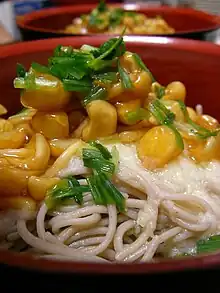 Nameko soba (Pholiota microspora mushrooms)
Nameko soba (Pholiota microspora mushrooms)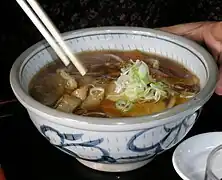 Kamonanban (Duck)
Kamonanban (Duck) Korokke soba
Korokke soba Tempura soba (Kakiage)
Tempura soba (Kakiage)
Soba served on special occasions
Soba is traditionally eaten on New Year's Eve in most areas of Japan, a tradition that survives to this day (Toshikoshi soba; English: from one year to another).[15][16] In the Tokyo area, there is also a tradition of giving out soba to new neighbors after a house move (Hikkoshi soba), although this practice is now rare.[15]
Nutritional value of soba
100 grams of cooked soba yields 99 kcal (410 kJ) of energy.[17] Soba contains all nine essential amino acids,[15] including lysine, which common wheat does not contain.[18]
Soba contains a type of polysaccharide that is easily digested. Soba noodles also contain antioxidants, including rutin and quercetin, and essential nutrients including choline, thiamine and riboflavin.[18]
Varieties of soba noodles and types of soba in Japan

.jpg.webp)
Buckwheat is ready for harvest in three months, allowing four crops a year, mainly in spring, summer, and autumn. In Japan, buckwheat is produced mainly in Hokkaido.[19] Soba that is made with newly harvested buckwheat is called shin-soba. It is sweeter and more flavorful than regular soba.
Nagano Prefecture is famous for soba. The noodles are known as shinshu soba. One of the reasons for this popularity is that Nagano has natural features well-suited to soba production. The land has plenty of volcanic ash soil because of its highland location. It also has an extreme difference in temperatures. Many famous soba production centers can be found across the prefecture, from the Kurohime and Togakushi highlands in the north to the Kaida highlands in the south, and the prefecture boasts the second-highest production of soba in Japan. Many facilities are also engaged in integrated soba manufacturing, from cultivation to milling and cutting. Many of these facilities provide soba cutting courses for customers, forming one of the major leisure activities of Nagano.[20] Soba noodles are produced by mixing buckwheat flour with some wheat flour (to reduce brittleness), adding water, mixing, kneading, rolling and cutting. As a general rule, only noodles containing 40% or more soba flour can carry the shinshu name.[21]
By location
- Etanbetsu soba: named after the central region of Hokkaidō (Asahikawacity)
- Izumo soba: named after Izumo in Shimane
- Izushi soba: named after Izushi in Hyōgo
- Shinshu soba: named after the old name of Nagano Prefecture. Also known as Shinano soba. (Shinano=Shinshu).
By ingredients
- Cha soba: flavored with green tea powder[18]
- Hegi soba: flavored with funori(布海苔) seaweed, originated in Uonuma, Niigata
- Inaka soba: "country soba", thick soba made with whole buckwheat
- Jinenjo soba: flavored with wild yam, Japanese yam or Chinese yam flour[18]
- Ni-hachi soba: soba containing 20% wheat and 80% buckwheat
- Sarashina soba: thin, light-colored soba, made with refined buckwheat
- Towari soba or Juwari soba: 100% buckwheat soba.
- Yomogi soba: flavored with mugwort
Soba restaurants
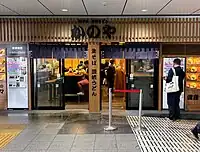
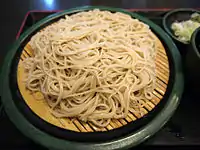
Sunaba, Chōjyu-an, Ōmura-an, Shōgetsu-an, Masuda-ya, Maruka are typical soba restaurants Yagō in Japan (Kantō region), from old time.[22]
Some restaurants have delivery service by scooters (Honda Super Cub)[22] or bicycles.
Moreover, they are a popular inexpensive fast food at railway stations.[23] Mainly, busy salarymen use the service.
Other uses of the word soba

Soba is also the Japanese word for buckwheat (Fagopyrum esculentum).[24] Roasted buckwheat kernels may be made into a grain tea called sobacha, which may be served hot or cold. Buckwheat hulls, or sobakawa (also called sobagara), are used to fill pillows. Sometimes, beers are made with roasted buckwheat added as a flavoring, and called "soba ale".[25]
Soba is occasionally used to refer to noodles in general. In Japan, ramen is traditionally called chūka soba (中華そば) or, before the end of the Second World War, shina soba (支那そば). Both of these mean "Chinese noodles", though the word shina was replaced by chūka because the Chinese considered the former term offensive.[26] Parboiled chūka soba is stir-fried to make yakisoba.[27] The name ramen is the Japanese pronunciation of the Chinese lamian (拉麺).[28] Mazesoba (also called abura soba or Taiwan mazesoba) is another ramen based dish.[29] Note that these noodles do not contain buckwheat. In this context, 'soba' noodles proper are called nihon soba (日本蕎麦, 'Japanese soba') as opposed to chūka soba.
In Okinawa, soba usually refers to Okinawa soba,[30] a completely different dish of noodles made out of flour, not buckwheat.[31] Okinawa soba is also quite popular in the city of Campo Grande (Brazil),[32] due to influence of Okinawan immigrants. It is eaten all-year long at street markets or in special restaurants called "sobarias".[33] As of 2019, the recipe has deviated from Okinawa style to suit Brazilian local preferences.[33]
See also
References
- ↑ Mente, Boye Lafayette De (2007). Dining Guide to Japan: Find the Right Restaurant, Order the Right Dish, and. Tuttle Publishing. p. 70. ISBN 978-4-8053-0875-2.
- ↑ Andoh, Elizabeth; Beisch, Leigh (2005). Washoku: recipes from the Japanese home kitchen. Ten Speed Press. p. 34. ISBN 978-1-58008-519-9.
- ↑ Watson, James L. (1997). Golden arches east: McDonald's in East Asia. Stanford University Press. p. 165. ISBN 978-0-8047-3207-9.
- ↑ Lien, Marianne E.; Nerlich, Brigitte (2004). The politics of food. Berg Publishers. p. 127. ISBN 978-1-85973-853-5.
- ↑ Udesky, James (1988). The book of soba. Kodansha International. p. 107. ISBN 978-0-87011-860-9.
- 1 2 3 4 5 6 "Soba Deliveryman from the series Occupations of Shōwa Japan in Pictures, Series 2". The Lavenberg Collection of Japanese Prints. May 12, 2018. Archived from the original on January 27, 2021.
- ↑ Barakan, Mayumi Yoshida; Greer, Judith Connor (1996). Tokyo city guide. Tuttle Publishing. p. 83. ISBN 978-0-8048-1964-0.
- ↑ Toussaint-Samat, Maguelonne (2009). A History of Food. Oxon, UK: Wiley-Blackwell. p. 171. ISBN 9781444305142.
- 1 2 3 Ishige, Naomichi (17 June 2014). History Of Japanese Food. London, UK: Routledge. pp. 249–251. ISBN 9781136602559.
- ↑ Homma, Gaku (1991). The folk art of Japanese country cooking: a traditional diet for today's world. North Atlantic Books. p. 91. ISBN 978-1-55643-098-5.
- ↑ Ang, Catharina Y.W.; Liu, KeShun; Huang, Yao-Went, eds. (1999). Asian Foods: Science and Technology. PA, USA: Technomic Publishing Co. p. 120. ISBN 9781566767361.
- 1 2 Itoh, Makiko (2015-05-15). "Nanban dishes are fit for a barbarian". The Japan Times. Retrieved 2021-01-27.
- 1 2 Itoh, Makiko (2018-11-17). "A comforting udon noodle recipe for the winter season". The Japan Times. Retrieved 2021-01-27.
- 1 2 Ashkenazi, Michael; Jacbons, Jeanne (2003). Food Culture in Japan. CT, USA: Greenwood Press. p. 37. ISBN 9780313324383.
- 1 2 3 Homma, Gaku (1990). The Folk Art of Japanese Country Cooking: A Traditional Diet for Today's World. California, USA: North Atlantic Books. p. 91.
- ↑ Tsuchiya Haruhito (2008). Customs of Japan. Ibc Publishing. p. 61. ISBN 978-4-89684-693-5.
- ↑ "Basic Report: 20115, Noodles, Japanese, soba, cooked". US Department of Agriculture National Nutrient Database for Standard Reference Release 28. Archived from the original on 2016-10-09. Retrieved April 19, 2016.
- 1 2 3 4 Belleme, Jan (2007). Japanese Foods That Heal. Vermont, USA: Tuttle Publishing. p. 126. ISBN 9780804835947.
- ↑ 平成20年産 そばの作付面積及び収穫量 [2008 Crop acreage and yields of buckwheat] (PDF) (in Japanese). The Ministry of Agriculture, Forestry and Fisheries of Japan. 2009-01-29. p. 7.
- ↑ Shinshu Soba Noodles. (2014). Retrieved from Japan Brand: https://japan-brand.jnto.go.jp/foods/noodles/2801/.
- ↑ Story of Japanese Local Cuisine. (2018). Retrieved from Kyoudo-ryouri.com: http://kyoudo-ryouri.com/en/food/1507.html.
- 1 2 やぶ光トピックス 三ツ沢商店街振興会公式ホームページ
- ↑ Mente, Boye Lafayette De (2007). Dining Guide to Japan: Find the Right Restaurant, Order the Right Dish, and. Tuttle Publishing. p. 70. ISBN 978-4-8053-0875-2.
- ↑ Rein, Johannes Justus (1889). The Industries of Japan: Together with an Account of its Agriculture, Forestry, Arts, and Commerce. From Travels and Researches Undertaken at the Cost of the Prussian Government. Hodder and Stoughton. p. 55.
- ↑ Cecchini, Toby (5 November 2006). "Ales in Comparison". The New York Times. Retrieved 28 June 2017.
- ↑ Cwiertka, Katarzyna Joanna (2006). Modern Japanese cuisine: food, power and national identity. Reaktion Books. pp. 144–145. ISBN 978-1-86189-298-0.; p145
- ↑ Itoh, Makiko (18 May 2019). "Yakisoba stir-fried noodles: A quick, easy and adaptable meal". The Japan Times. Archived from the original on 2021-04-29. Retrieved 27 July 2021.
- ↑ Kodansha encyclopedia of Japan, Volume 6 (1st ed.). Tokyo: Kodansha. 1983. p. 283. ISBN 978-0-87011-626-1.
- ↑ MATCHA. "Ramen, Tsukemen and Soba Noodles - What Is The Difference?". MATCHA - JAPAN TRAVEL WEB MAGAZINE. Retrieved 2019-07-10.
- ↑ "Okinawa soba" 沖縄そば(茹麺・生麺). Honbano Honmono (in Japanese). Archived from the original on 2021-07-27. Retrieved 2021-07-27.
(translation): ...Okinawans call this noodle soba or in dialect suba...
- ↑ Lima, Daniela (2018-08-07). "Sobarias de Campo Grande se reúnem para discutir preservação da receita do prato típico da cidade". Rede Educativa MS (in Portuguese). Archived from the original on 2020-06-21.
- 1 2 "VI-2 Feira Central". Terra de Esperança – Kibo no Daitsi (PDF) (in Portuguese and Japanese). Campo Grande, Brasil: Associação Okinawa de Campo Grande – MS. 2019 [2014]. pp. 554–556. Archived (PDF) from the original on 2021-07-27. (Associação Okinawa de Campo Grande – MS website)
External links
- Tokyo soba chef making noodles by hand from scratch—illustrated article in English
- Soba restaurant owner in Nagano making soba noodles—slide show with English subtitles
- Cook makes homemade soba noodles—video with English and Japanese subtitles
